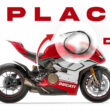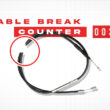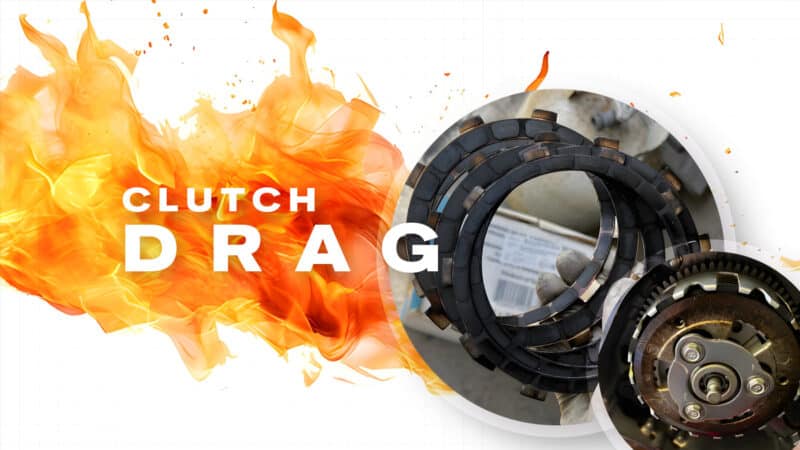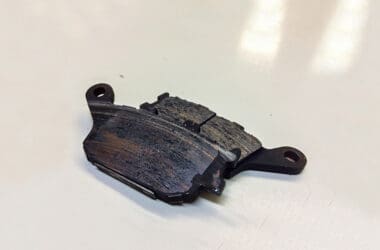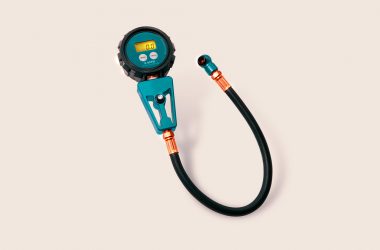Table of Contents Show
If your motorcycle has a dragging clutch also known as a sticking clutch, then it can lead to multiple issues and can potentially cause major damage to several parts of the clutch assembly.
Motorcycle clutch dragging occurs when the friction plates and the steel plates of the clutch pack won’t disengage and get stuck together even when the clutch lever is completely pulled in. Motorcycle lurching forward when changing gears or stalling on first gear are the common and obvious signs of a dragging clutch.
It’s a common issue in motorcycles that are not properly maintained and can damper your riding experience.
In this ultimate guide, we’ll delve into what motorcycle clutch drag means in detail, why it happens, the symptoms to watch out for, the possible causes, and, most importantly, how to fix it.
We’ll also touch on the cost involved in resolving this problem.
What Does Motorcycle Clutch Drag Mean?
Motorcycle clutch drag is a situation where the clutch does not completely disengage from the engine when you pull in the clutch lever.
In simple terms, A motorcycle with a dragging clutch will have the clutch plates stuck together or stay compressed even when you completely pull in the clutch lever. This creates friction/drag among the clutch plates which consist of friction plates and steel plates resulting in damaged or burned clutch.
A motorcycle with clutch drag will not let the clutch disengage and cut off the power to the rear wheel, this will result in the motorcycle moving forward even when you want it to come to a complete stop.
Why Does My Motorcycle Clutch Drag & Its Causes?
There are several reasons/causes why your motorcycle clutch might be dragging and the majority of the root causes are related to the condition of the clutch assembly.
Apart from the clutch cable and clutch clever, the clutch assembly holds the most important parts of the clutch unit such as clutch plates, clutch basket, inner hub, pressure plate, etc which are the sole reason for a motorcycle to shift gears smoothly and transfer power efficiently.
Now let’s look into why your motorcycle clutch is dragging and what are the causes behind it.
1. Worn Clutch Plates
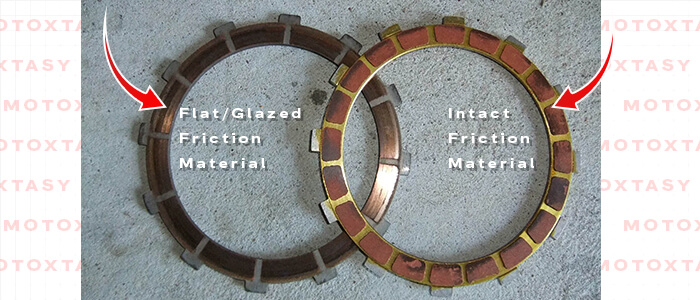
Over time, the clutch plates can wear out, the clutch plates of the clutch pack consist of friction plates and steel plates.
Worn clutch plates will have glazed-over friction material of the friction plates or burned/bluing or bending of the steel plates. Other signs of damage may include chipping of their teeth.
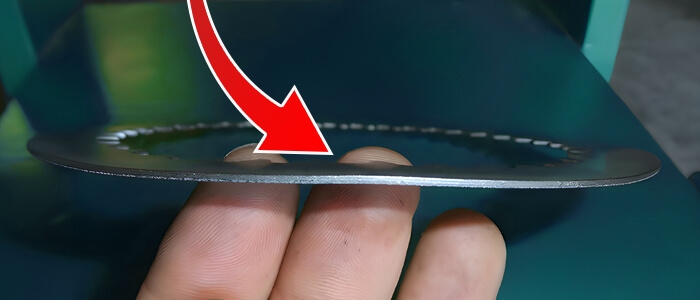
Damaged clutch plates can get stuck with each other and will be harder to disengage/separate even when you pull in the clutch lever. The clutch lever might also get harder to pull.
2. Contaminated Engine Oil
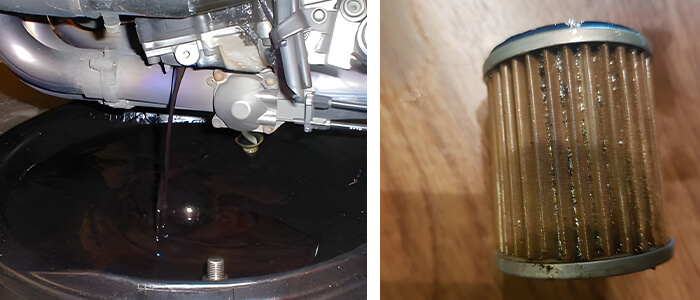
Old engine oil or dirty oil filter has contaminants such as dirt or small particles of chaffed metal caused due to friction between the moving parts of the engine.
These contaminants will be circulating inside the engine and clutch assembly. Due to high engine temperature, the contaminated oil will get sticky which will also cause the contaminants to cover the clutch assembly parts resulting in more friction and sometimes clutch plates getting stuck together.
So if contaminated engine oil stays inside the engine, it will eventually find its way to get in between and around the clutch plates resulting in improper clutch disengagement.
3. Improper Clutch Cable & Lever Adjustment
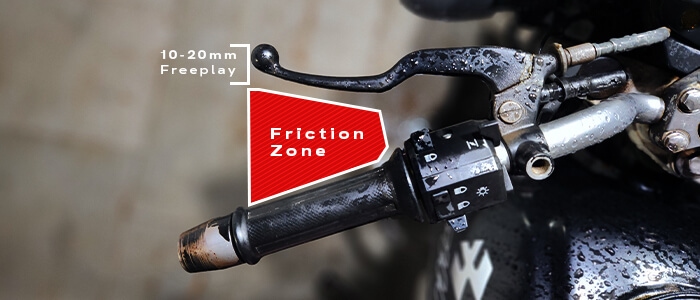
Clutch cable slack adjustment and the right amount of free-play in the clutch lever play an important role in engaging and disengaging the clutch fully.
Incorrect clutch cable adjustment can cause the clutch to disengage partially and it’s essential to maintain the right amount of free play in the clutch lever typically between 10-20mm for OEM clutch levers.
2-4mm clutch lever free play from the start of the lever for aftermarket levers due to their shorter length.
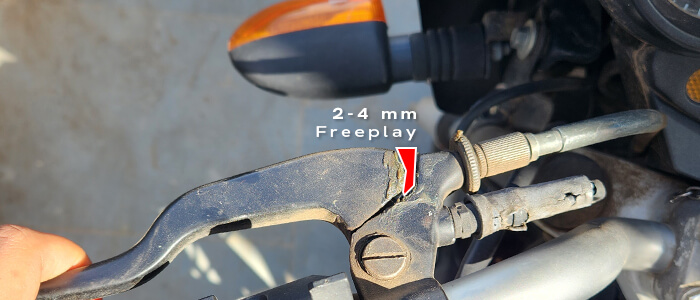
Wrong adjustment of the clutch cable and lever will cause the motorcycle’s clutch to not disengage fully even when the clutch lever is pulled in, resulting in clutch drag.
4. Damaged Clutch Basket Or Inner Hub
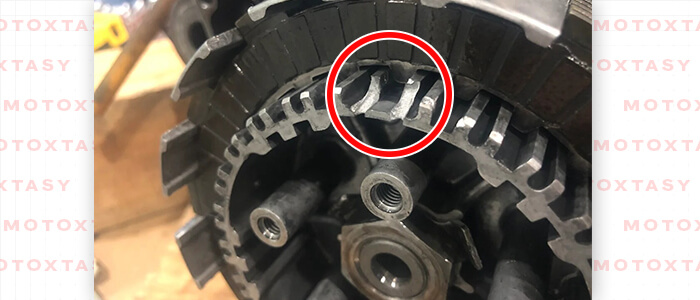
A damaged or worn clutch basket or inner hub will have signs of chipping, cracks, or notching/grooves on clutch basket fingers or inner hub teeth.
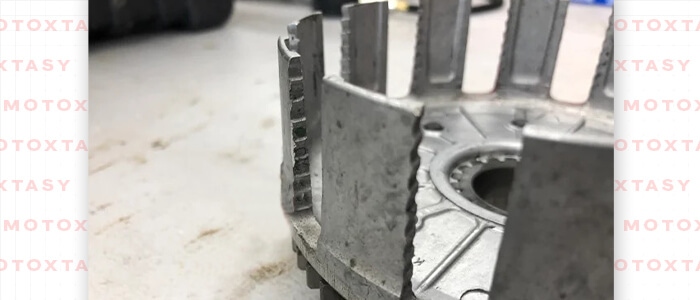
These notches/grooves will cause the clutch plates to not move freely or rather engage or disengage properly. The clutch plate’s inner or outer circumference teeth could get stuck inside these grooves which would result in harsh gearshift and obviously clutch drag.
5. Corroded or Bent Clutch Springs Or Bolts
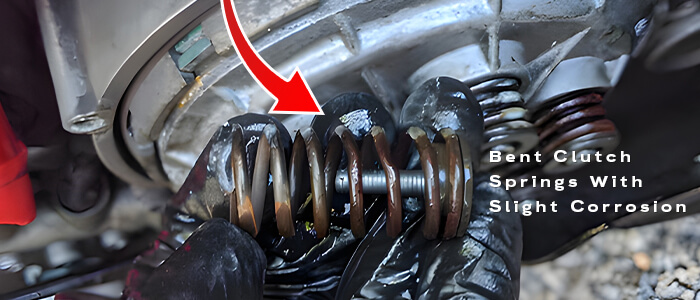
Clutch bolts hold the pressure plate on top of the clutch plates and the clutch springs regulate the compression/pressure on the plates when you pull in or release the clutch lever.
Corrosion or bending of the clutch springs or bolts will cause the the pressure plate to either lose its tension or cause the clutch plates to not disengage which would ultimately create a clutch dragging situation.
So it is necessary for the clutch springs and bolts to be in good condition for the functioning of the clutch.
6. Failing Hydraulic Clutch System
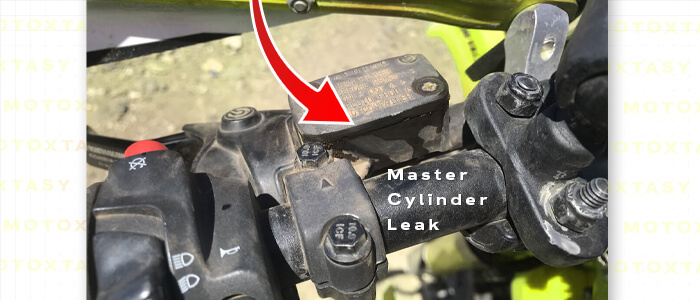
A failing hydraulic clutch system which will create a clutch dragging problem will either have a leak in the master or slave cylinder or the whole clutch system is not properly bled.
Air in the hydraulic clutch system or any leak will not disengage or engage to clutch properly. So inspect for any of these kinds of damages.
So these were the most common causes/reasons behind why your motorcycle clutch is dragging.
Motorcycle Clutch Drag Symptoms
Now we can look into some early symptoms and common symptoms of a motorcycle when its clutch is dragging.
Identifying clutch drag is crucial to addressing the issue promptly. Look out for these telltale signs.
- Difficulty Shifting Gears: When you have a dragging clutch, shifting gears becomes challenging and the gear shifts will be harsh and clunky.
- Stalling On 1st Gear: The motorcycle might stall when you come to a stop or stall when you shift gear from neutral and 1st gear as the clutch doesn’t disengage completely.
- Dragging Sensation: You’ll feel a sensation that the motorcycle is pulling or lurching forward even when the clutch lever is partially pulled in.
- Loud Metallic Noises: A dragging clutch can produce loud noises such as grinding or clanking every time while shifting the gear.
- Motorcycle Lurching Forward: The motorcycle will lurch forward at a lower speed due to the clutch not being disengaged and the power or momentum of forward lurch will be stronger at lower Rpm.
How To Fix A Dragging Clutch In A Motorcycle?
Now that we’ve covered the symptoms and causes, let’s explore how to fix a dragging clutch.
To fix a dragging clutch in your motorcycle, you will have to replace the damaged clutch friction plates and steel plates or clutch housing parts such as the clutch basket or inner hub. Other tiny inspection such as right clutch cable adjustment and free play of the clutch lever is also important to avoid ineffective disengagement of the clutch.
Adjusting the right amount of clutch cable tension/slack and clutch lever free play should be mandatory, so if this prerequisite is already in good state then looking for damage or wear of the clutch assembly parts is necessary.
The main reason for a motorcycle to have clutch drag is always due to grooving on the clutch basket finger, chipping of inner hub teeth, or damaged clutch plates, and replacing these damaged parts will fix the clutch dragging problem.
These parts of the clutch assembly are integral for the smooth functioning of a clutch and should be a go-to inspection region if the clutch is dragging.
How Much Does It Cost To Fix A Dragging Clutch?
The cost of fixing a dragging clutch can vary widely depending on the extent of the issue and the specific motorcycle model.
But a rough estimate of a couple of hundred dollars to a thousand dollars should be expected to fix a dragging clutch if replacement of the damaged clutch assembly parts is needed.
But here’s a price/cost breakdown for each major part of the clutch assembly that needs to be replaced to fix motorcycle clutch drag.
- Clutch Plate Replacement:
This can cost anywhere from $150 to $800, plus labor charges depending upon the make/type of the motorcycle. Generally, liter-class bikes need good quality clutch plates which are expensive. - Clutch Cable Replacement:
Expect to pay around $30 to $100 for the cable itself, plus labor costs depending upon where you get it fixed. - Clutch Spring Replacement:
Springs are relatively affordable, usually in the $10 to $50 range, with labor charges on top. - Hydraulic Clutch System Repairs:
If there are hydraulic issues, the cost can be more substantial, ranging from $300 to $800 or more. - Clutch Basket & Inner hub:
A new clutch basket will cost you around $200-$400 and the inner hub will cost you around $100-$400 and may involve a few hours of labor costs, typically in the $50 to $100 range. - Clutch Cable & Lever Adjustment:
Adjusting the lever and cable tension/slack is usually a simple task and may not involve significant costs.
Conclusion
In conclusion, a dragging clutch is a common issue for motorcycle riders, but it’s not something you should ignore.
Understanding the causes and symptoms is the first step, and then taking the appropriate measures to fix it is crucial.
While the cost of repairs can vary, addressing the issue promptly will ensure a safer and more enjoyable riding experience.

